Books by Antonella D'Ovidio
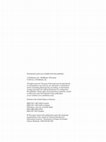
Lelio Colista, Complete Trio sonatas, edited by Antonella D'Ovidio, «Recent Research in the Music of Baroque Era, 224», Madison, Wisconsin, A-R Editions, 2021, 2021
Lelio Colista (1629–80) is considered the foremost composer of Italian trio sonatas in Rome befor... more Lelio Colista (1629–80) is considered the foremost composer of Italian trio sonatas in Rome before Corelli. In the Papal City, where he lived for most of his life, he was an acclaimed lutenist, composer, and teacher. He was part of a closely-knit professional milieu including the most appreciated instrumentalists of his generation, such as Alessandro Stradella, Carlo Ambrogio Lonati, and Carlo Mannelli. However, Colista’s trio sonatas were not published during his lifetime. No autograph has survived, and the many manuscript sources are today scattered throughout various
European libraries. Their wide dissemination bears witness to the significant circulation of Colista’s trio sonatas in the last decades of the seventeenth century, particularly in England. This volume presents a critical edition of the complete output of Colista’s trio sonatas and offers for the first time a full reassessment of the entire manuscript transmission, including all the known sources and concordances, as well as incomplete and doubtful works.

Questo volume è stato realizzato grazie a un contributo del Ministero dell'Istruzione, dell'Unive... more Questo volume è stato realizzato grazie a un contributo del Ministero dell'Istruzione, dell'Università e della Ricerca, erogato alle Università degli Studi di Padova, Siena e Milano nell'ambito del progetto Libretti d'opera italiana del Settecento (Mariani, Federico, Metastasio, Goldoni, Verazi). Varianti dai manoscritti e dalle fonti a stampa (FIRB 2006) INTRODUZIONE Quarta opera seria di Niccolò Jommelli (Aversa 1714 -Napoli 1774) composta per i teatri romani, Didone abbandonata va in scena al Teatro Argentina il 28 gennaio 1747, secondo titolo della stagione di carnevale. 1 Come per Johann Adolf Hasse, 2 l'incontro con la drammaturgia metastasiana sarà determinante per il teatro di Jommelli: attorno all'universo del poeta cesareo, il compositore di Aversa costruirà e consoliderà il proprio stile operistico con una produzione di drammi per musica in cui un posto numericamente rilevante è occupato da opere ricomposte a distanza di anni su uno stesso libretto. 3 È quel che avviene anche nel caso di Didone abbandonata che Jommelli mise in musica in altre due occasioni: appena due anni dopo, nel 1749, per la corte di Vienna e nel 1763 per la corte di Stoccarda. Non si tratta di revisioni della stessa opera in anni differenti, ma di tre intonazioni indipendenti dello stesso libretto, sebbene, com'è intuibile, si riscontrino soluzioni compositive condivise, soprattutto nel caso della Didone romana e di quella viennese composte nel giro di pochissimi anni.
Articles by Antonella D'Ovidio
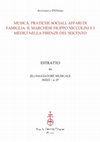
The article examines the musical activities nanced by marquis Filippo Niccolini (1586-1666), a l... more The article examines the musical activities nanced by marquis Filippo Niccolini (1586-1666), a leading member of one of the most in uential Florentine families and, from 1630, maestro di camera to Giovan Carlo de’ Medici, son of Grand Duke Cosimo II. On the basis of the documents found in the fam- ily archives, the rst part of the article examines Filippo’s musical interests in the decades 1640-60, the organization of musical academies in his palaces, the train- ing and protection given to young musici and virtuose, the intense relations with composers active in Rome (Stefano Landi, Girolamo Frescobaldi, and especially Luigi Rossi). The second part focuses on Niccolini as a leading intermediary for Medicean spectacles: he had a key role in selecting singers to be hired for some important productions – a case in point is Antonio Cesti’s Orontea – and, more generally, was able to exert a considerable in uence on the relationships between the Medici and the musicians at their service, thanks to his musical knowledge and his network of contacts.
The Marquis’s musical interests and activities – both as a patron “in his own right” and as an intermediary – reveal themselves to be not simply an emulation of the dominant Medicean taste, but rather one of the main elements of a speci c cultural policy, implemented so as to consolidate the image of his own family and to reinforce its in uence on that of the Grand Duchy. This helps us re ect on the function of music within the social practices of a patriciate that sought to position itself on the cultural and political chessboard of seventeenth-century Florence. Furthermore, it leads us to rethink musical patronage in the light of a system of relations between the Medici and the patrician families that was much more com- plex than has hitherto been supposed.
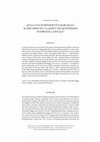
Philomusica on-line, 2020
SUMMARY
The article focuses on a hitherto forgotten episode of micro-history in the musical life... more SUMMARY
The article focuses on a hitherto forgotten episode of micro-history in the musical life of nineteenth-century Florence, exploring it in the context of the political, social, and cul- tural traumatic changes affecting the city after its proclamation as temporary capital of the Kingdom of Italy. This episode concerns the revival and ‘continuation’ of Marcello’s Estro poetico armonico, financed by the Florentine patrician Simone Vincenzo Velluti Zati and commissioned to Antonio Bazzini and Ferdinando Giorgetti in . The pro- ject was promoted by personalities like Abramo Basevi and music critics like Girolamo Alessandro Biaggi and Francesco D’Arcais. Unpublished documents relating to this ini- tiative and the articles published by Biaggi and D’Arcais in «La Nazione» and «L’Opin- ione» show how the intertwining of the municipal and national dimension also had re- percussions on the discourse about music and Florentine musical life carried out by the periodical press in those years. The «revival» of Marcello promoted by the Duke, the discourse on the «classics» continually invoked by the local press reveal a search for iden- tity intersecting the musical life, as well as the image and perception of the city itself.
KEYWORDS Benedetto Marcello, Duca di San Clemente, Girolamo Alessandro Biaggi, Fi- renze Capital of the Kingdom of Italy, music criticism Ninenteenth century
Abstract in italiano:
L’articolo ricostruisce un episodio di microstoria, finora dimenticato, della vita musicale della Firenze ottocentesca, rileggendolo alla luce dei cambiamenti politici, sociali e cultu- rali traumatici, che investono la città all’indomani della sua proclamazione come Capitale provvisoria del Regno d’Italia. Si tratta del progetto della ripresa e «continuazione» dell’Estro poetico armonico di Benedetto Marcello, finanziato dal patrizio fiorentino Si- mone Vincenzo Velluti Zati e da lui affidato nel a Antonio Bazzini e Ferdinando Giorgetti. Il progetto fu promosso da personalità come Abramo Basevi e da critici musi- cali come Girolamo Alessandro Biaggi e Francesco D’Arcais. I documenti relativi a questa iniziativa e gli interventi pubblicati da Biaggi e D’Arcais su «La Nazione» e «L’Opinione» fanno comprendere come l’intreccio tra realtà municipale e dimensione nazionale si ri- percuota anche sul discorso attorno alla musica e alla vita musicale fiorentina portato avanti dalla stampa quotidiana di quegli anni. Il ‘ritorno’ a Marcello voluto dal Duca e il discorso sulla necessità dei ‘classici’ continuamente proposto dai quotidiani assumono il valore di una ricerca identitaria collettiva che coinvolge la vita musicale, così come l’im- magine e la percezione stessa della città.
PAROLE CHIAVE Benedetto Marcello, Duca di San Clemente, Girolamo Alessandro Biaggi, Firenze Capitale, critica musicale dell’Ottocento
«Una stanza tutta per sé»: la camera della virtuosa di musica Lucia Coppa nella Villa di Camugliano di Filippo Niccolini, in Le stanze del Palazzo. Gli ambienti della vita nelle carte d’archivio, Quaderni a cura dell’Associazione Archivi storici delle famiglie, Pisa, Pacini, 2019, pp.19-28.
«Con dolce forza». Donne nell'universo musicale del Cinque e del Seicento, catalogo della mostra a cura di Laura Donati, Firenze, Edizioni Polistampa, 2018, pp. 15-28., 2018
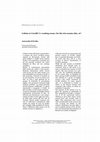
Philomusica on-line» – Rivista del Dipartimento di Musicologia e beni culturali, 2017
Recent research on manuscript and printed sources of Corelli’s output have re-opened discussion o... more Recent research on manuscript and printed sources of Corelli’s output have re-opened discussion on doubtful works and have led to a new revision of Marx’s classification of Corelli’s catalogue.
While the solo sonatas of doubtful attribution have already been re-examined, there is still much to be done on doubtful trio sonatas. In this respect, this essay focuses on a specific case: the conflicting attribution of trio sonata Ahn. 16 classified by Marx among Corelli’s doubtful works and attested in a group of English sources, only rarely examined by Corelli scholars. In some sources Ahn. 16 is attributed to Corelli, in others to the Roman lutenist and composer Lelio Colista, in others no ascription is reported.
The purpose of this article is to explore the question of authorship of this composition through a comparison of all the manuscript sources, offering an up-to-date survey (some sources have only recently come to light). This comparison and a more wide consideration of the sources not only re-opens the debate on the sonata’s attribution, but also offers a more complete picture of the circulation and manuscript dissemination of Roman trio sonatas in England.
Mapping Roman Triosonata before Corelli: history, geography and dissemination
Proceedings of the Conference «Eine Geographie der Triosonate: Neue Perspektiven», Universität Freiburg, May 2015
Una Capitale europea: società, cultura, urbanistica nella Firenze post-unitaria, a cura di P. Marchi e L. Lucchesi, Firenze, Edizioni dell'Assemblea, 2018, pp. 583-606., 2018
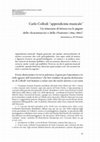
Musica e musicisti nell'Italia dell'Ottocento attraverso i quotidiani, a cura di A. Guarnieri, I. Macchiarella, F. Nicolodi, Roma, Aracne, 2017, pp. 55-84., 2017
Carlo Collodi "appendicista musicale" Un itinerario di lettura tra le pagine dello «Scaramuccia» ... more Carlo Collodi "appendicista musicale" Un itinerario di lettura tra le pagine dello «Scaramuccia» e della «Nazione» (-) A D'O Appendicista musicale. Regola generale: per parlare autorevolmente di musica occorrono due cose principalissime: non saper nulla di musica e figurarsi d'essere un grand'intelligente. La musica e la politica sono due materie di dominio pubblico: tutti ne possono discorrere a dritto e a rovescio: anche i sordi e gli analfabeti. Prova ne sia che le quistioni musicali e politiche, quando finiscono, finiscono quasi sempre così: che nessuno ha torto e nessuno ha ragione. Carlo Collodi "appendicista musicale" a doppio filo con gli accadimenti storici e musicali . Significativo in tal senso -ma gli esempi potrebbero essere molti -l'articolo di Collodi apparso nella «Nazione» del dicembre , in cui l'autore fornisce un infiammato resoconto di una serata patriottica al Teatro Pagliano di Firenze, protagonista il soprano Marietta Piccolomini:
Atti e Memorie dell'Accademia Toscana di Scienze e Lettere «La Colombaria», volume LXXXI, nuova serie- LXVII, 2016, Firenze, Olschki, 2017, pp. 283-300.
L’Astianatte di Jommelli: «una musica singolarissima che ne riportò l’applauso di tutta Roma». Modelli stilistici e drammaturgia (con una nuova fonte sull’orchestra del Teatro Argentina, 1741)
«Jommelliana», 2017
Corelli e l’«angoscia dell’influenza»: declinazioni corelliane nelle sonate di Francesco Maria Veracini
Arcomelo 2013. Studi nel terzo centenario della morte di Arcangelo Corelli (1653-1713), a cura di Guido Olivieri e Marc Vanscheeuwijck, Lucca, LIM, 2015 (Biblioteca Musicale Lim - Saggi), pp. 447-473.
Firenze e la musica. Fonti, protagonisti, committenza. Scritti in ricordo di Maria Adelaide Bartoli Bacherini, a cura di C. Bacherini, G. Sciommeri, A. Ziino
Colista, Lonati, Stradella: modelli compositivi della sonata a tre a Roma prima di Corelli
Conference presentation by Antonella D'Ovidio

Spazi e luoghi della committenza musicale a Firenze nel Seicento: le residenze del marchese Filippo Niccolini, XXVI convegno annuale Società italiana di musicologia (Matera, 18-20 ottobre 2019)
Studi recenti hanno messo in luce il ruolo centrale che la committenza musicale delle famiglie pa... more Studi recenti hanno messo in luce il ruolo centrale che la committenza musicale delle famiglie patrizie ha giocato nella vita musicale e spettacolare della Firenze seicentesca, contribuendo in tal modo a spostare lo sguardo dalla corte medicea ad un più composito e sfaccettato scenario musicale urbano.
Lo studio puntuale di tale scenario necessita di un’indagine che, oltre che sulle musiche e sulle modalità della committenza, si interroghi anche sui luoghi e sugli spazi riservati alle esecuzioni musicali nei numerosi palazzi di famiglia che all’epoca costellavano lo spazio cittadino. La duplice natura di questi ambienti – dimore private, ma al tempo stesso simboli tangibili del prestigio acquisito dalla casata – consente una riflessione su come la musica, in rapporto alla dimensione visiva e simbolica dello spazio prescelto, contribuisse alla creazione di un complesso sistema di autorappresentazione sociale e culturale del patriziato: una questione, questa, ancora non completamente messa a fuoco nel caso della Firenze seicentesca.
Sulla scorta di queste premesse metodologiche, l’intervento si focalizzerà su alcuni aspetti della committenza musicale del marchese Filippo Niccolini (1586-1666) in relazione agli spazi da lui allestiti per ospitare esecuzioni musicali nelle sue diverse residenze cittadine e suburbane. Si analizzerà in particolare il caso di Palazzo Ricasoli alla Carraia, dove Niccolini dimorò dal 1642 al 1648 e dove aveva iniziato ad allestire la sua collezione di quadri e di strumenti musicali. Incrociando i dati provenienti dall’archivio privato della famiglia con quanto già noto sulla storia di questo palazzo, si tenterà di ricostruire le caratteristiche (spaziali, visive e simboliche) di uno specifico ambiente interno, allestito per le esecuzioni musicali patrocinate dal marchese, che proprio in quel torno di anni si impone come attore tra i più influenti della committenza patrizia fiorentina.
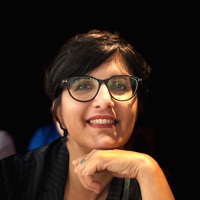




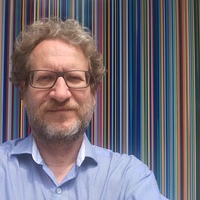


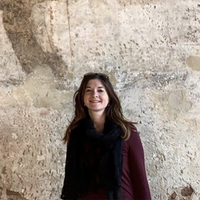


Uploads
Books by Antonella D'Ovidio
European libraries. Their wide dissemination bears witness to the significant circulation of Colista’s trio sonatas in the last decades of the seventeenth century, particularly in England. This volume presents a critical edition of the complete output of Colista’s trio sonatas and offers for the first time a full reassessment of the entire manuscript transmission, including all the known sources and concordances, as well as incomplete and doubtful works.
Articles by Antonella D'Ovidio
The Marquis’s musical interests and activities – both as a patron “in his own right” and as an intermediary – reveal themselves to be not simply an emulation of the dominant Medicean taste, but rather one of the main elements of a speci c cultural policy, implemented so as to consolidate the image of his own family and to reinforce its in uence on that of the Grand Duchy. This helps us re ect on the function of music within the social practices of a patriciate that sought to position itself on the cultural and political chessboard of seventeenth-century Florence. Furthermore, it leads us to rethink musical patronage in the light of a system of relations between the Medici and the patrician families that was much more com- plex than has hitherto been supposed.
The article focuses on a hitherto forgotten episode of micro-history in the musical life of nineteenth-century Florence, exploring it in the context of the political, social, and cul- tural traumatic changes affecting the city after its proclamation as temporary capital of the Kingdom of Italy. This episode concerns the revival and ‘continuation’ of Marcello’s Estro poetico armonico, financed by the Florentine patrician Simone Vincenzo Velluti Zati and commissioned to Antonio Bazzini and Ferdinando Giorgetti in . The pro- ject was promoted by personalities like Abramo Basevi and music critics like Girolamo Alessandro Biaggi and Francesco D’Arcais. Unpublished documents relating to this ini- tiative and the articles published by Biaggi and D’Arcais in «La Nazione» and «L’Opin- ione» show how the intertwining of the municipal and national dimension also had re- percussions on the discourse about music and Florentine musical life carried out by the periodical press in those years. The «revival» of Marcello promoted by the Duke, the discourse on the «classics» continually invoked by the local press reveal a search for iden- tity intersecting the musical life, as well as the image and perception of the city itself.
KEYWORDS Benedetto Marcello, Duca di San Clemente, Girolamo Alessandro Biaggi, Fi- renze Capital of the Kingdom of Italy, music criticism Ninenteenth century
Abstract in italiano:
L’articolo ricostruisce un episodio di microstoria, finora dimenticato, della vita musicale della Firenze ottocentesca, rileggendolo alla luce dei cambiamenti politici, sociali e cultu- rali traumatici, che investono la città all’indomani della sua proclamazione come Capitale provvisoria del Regno d’Italia. Si tratta del progetto della ripresa e «continuazione» dell’Estro poetico armonico di Benedetto Marcello, finanziato dal patrizio fiorentino Si- mone Vincenzo Velluti Zati e da lui affidato nel a Antonio Bazzini e Ferdinando Giorgetti. Il progetto fu promosso da personalità come Abramo Basevi e da critici musi- cali come Girolamo Alessandro Biaggi e Francesco D’Arcais. I documenti relativi a questa iniziativa e gli interventi pubblicati da Biaggi e D’Arcais su «La Nazione» e «L’Opinione» fanno comprendere come l’intreccio tra realtà municipale e dimensione nazionale si ri- percuota anche sul discorso attorno alla musica e alla vita musicale fiorentina portato avanti dalla stampa quotidiana di quegli anni. Il ‘ritorno’ a Marcello voluto dal Duca e il discorso sulla necessità dei ‘classici’ continuamente proposto dai quotidiani assumono il valore di una ricerca identitaria collettiva che coinvolge la vita musicale, così come l’im- magine e la percezione stessa della città.
PAROLE CHIAVE Benedetto Marcello, Duca di San Clemente, Girolamo Alessandro Biaggi, Firenze Capitale, critica musicale dell’Ottocento
While the solo sonatas of doubtful attribution have already been re-examined, there is still much to be done on doubtful trio sonatas. In this respect, this essay focuses on a specific case: the conflicting attribution of trio sonata Ahn. 16 classified by Marx among Corelli’s doubtful works and attested in a group of English sources, only rarely examined by Corelli scholars. In some sources Ahn. 16 is attributed to Corelli, in others to the Roman lutenist and composer Lelio Colista, in others no ascription is reported.
The purpose of this article is to explore the question of authorship of this composition through a comparison of all the manuscript sources, offering an up-to-date survey (some sources have only recently come to light). This comparison and a more wide consideration of the sources not only re-opens the debate on the sonata’s attribution, but also offers a more complete picture of the circulation and manuscript dissemination of Roman trio sonatas in England.
Conference presentation by Antonella D'Ovidio
Lo studio puntuale di tale scenario necessita di un’indagine che, oltre che sulle musiche e sulle modalità della committenza, si interroghi anche sui luoghi e sugli spazi riservati alle esecuzioni musicali nei numerosi palazzi di famiglia che all’epoca costellavano lo spazio cittadino. La duplice natura di questi ambienti – dimore private, ma al tempo stesso simboli tangibili del prestigio acquisito dalla casata – consente una riflessione su come la musica, in rapporto alla dimensione visiva e simbolica dello spazio prescelto, contribuisse alla creazione di un complesso sistema di autorappresentazione sociale e culturale del patriziato: una questione, questa, ancora non completamente messa a fuoco nel caso della Firenze seicentesca.
Sulla scorta di queste premesse metodologiche, l’intervento si focalizzerà su alcuni aspetti della committenza musicale del marchese Filippo Niccolini (1586-1666) in relazione agli spazi da lui allestiti per ospitare esecuzioni musicali nelle sue diverse residenze cittadine e suburbane. Si analizzerà in particolare il caso di Palazzo Ricasoli alla Carraia, dove Niccolini dimorò dal 1642 al 1648 e dove aveva iniziato ad allestire la sua collezione di quadri e di strumenti musicali. Incrociando i dati provenienti dall’archivio privato della famiglia con quanto già noto sulla storia di questo palazzo, si tenterà di ricostruire le caratteristiche (spaziali, visive e simboliche) di uno specifico ambiente interno, allestito per le esecuzioni musicali patrocinate dal marchese, che proprio in quel torno di anni si impone come attore tra i più influenti della committenza patrizia fiorentina.
European libraries. Their wide dissemination bears witness to the significant circulation of Colista’s trio sonatas in the last decades of the seventeenth century, particularly in England. This volume presents a critical edition of the complete output of Colista’s trio sonatas and offers for the first time a full reassessment of the entire manuscript transmission, including all the known sources and concordances, as well as incomplete and doubtful works.
The Marquis’s musical interests and activities – both as a patron “in his own right” and as an intermediary – reveal themselves to be not simply an emulation of the dominant Medicean taste, but rather one of the main elements of a speci c cultural policy, implemented so as to consolidate the image of his own family and to reinforce its in uence on that of the Grand Duchy. This helps us re ect on the function of music within the social practices of a patriciate that sought to position itself on the cultural and political chessboard of seventeenth-century Florence. Furthermore, it leads us to rethink musical patronage in the light of a system of relations between the Medici and the patrician families that was much more com- plex than has hitherto been supposed.
The article focuses on a hitherto forgotten episode of micro-history in the musical life of nineteenth-century Florence, exploring it in the context of the political, social, and cul- tural traumatic changes affecting the city after its proclamation as temporary capital of the Kingdom of Italy. This episode concerns the revival and ‘continuation’ of Marcello’s Estro poetico armonico, financed by the Florentine patrician Simone Vincenzo Velluti Zati and commissioned to Antonio Bazzini and Ferdinando Giorgetti in . The pro- ject was promoted by personalities like Abramo Basevi and music critics like Girolamo Alessandro Biaggi and Francesco D’Arcais. Unpublished documents relating to this ini- tiative and the articles published by Biaggi and D’Arcais in «La Nazione» and «L’Opin- ione» show how the intertwining of the municipal and national dimension also had re- percussions on the discourse about music and Florentine musical life carried out by the periodical press in those years. The «revival» of Marcello promoted by the Duke, the discourse on the «classics» continually invoked by the local press reveal a search for iden- tity intersecting the musical life, as well as the image and perception of the city itself.
KEYWORDS Benedetto Marcello, Duca di San Clemente, Girolamo Alessandro Biaggi, Fi- renze Capital of the Kingdom of Italy, music criticism Ninenteenth century
Abstract in italiano:
L’articolo ricostruisce un episodio di microstoria, finora dimenticato, della vita musicale della Firenze ottocentesca, rileggendolo alla luce dei cambiamenti politici, sociali e cultu- rali traumatici, che investono la città all’indomani della sua proclamazione come Capitale provvisoria del Regno d’Italia. Si tratta del progetto della ripresa e «continuazione» dell’Estro poetico armonico di Benedetto Marcello, finanziato dal patrizio fiorentino Si- mone Vincenzo Velluti Zati e da lui affidato nel a Antonio Bazzini e Ferdinando Giorgetti. Il progetto fu promosso da personalità come Abramo Basevi e da critici musi- cali come Girolamo Alessandro Biaggi e Francesco D’Arcais. I documenti relativi a questa iniziativa e gli interventi pubblicati da Biaggi e D’Arcais su «La Nazione» e «L’Opinione» fanno comprendere come l’intreccio tra realtà municipale e dimensione nazionale si ri- percuota anche sul discorso attorno alla musica e alla vita musicale fiorentina portato avanti dalla stampa quotidiana di quegli anni. Il ‘ritorno’ a Marcello voluto dal Duca e il discorso sulla necessità dei ‘classici’ continuamente proposto dai quotidiani assumono il valore di una ricerca identitaria collettiva che coinvolge la vita musicale, così come l’im- magine e la percezione stessa della città.
PAROLE CHIAVE Benedetto Marcello, Duca di San Clemente, Girolamo Alessandro Biaggi, Firenze Capitale, critica musicale dell’Ottocento
While the solo sonatas of doubtful attribution have already been re-examined, there is still much to be done on doubtful trio sonatas. In this respect, this essay focuses on a specific case: the conflicting attribution of trio sonata Ahn. 16 classified by Marx among Corelli’s doubtful works and attested in a group of English sources, only rarely examined by Corelli scholars. In some sources Ahn. 16 is attributed to Corelli, in others to the Roman lutenist and composer Lelio Colista, in others no ascription is reported.
The purpose of this article is to explore the question of authorship of this composition through a comparison of all the manuscript sources, offering an up-to-date survey (some sources have only recently come to light). This comparison and a more wide consideration of the sources not only re-opens the debate on the sonata’s attribution, but also offers a more complete picture of the circulation and manuscript dissemination of Roman trio sonatas in England.
Lo studio puntuale di tale scenario necessita di un’indagine che, oltre che sulle musiche e sulle modalità della committenza, si interroghi anche sui luoghi e sugli spazi riservati alle esecuzioni musicali nei numerosi palazzi di famiglia che all’epoca costellavano lo spazio cittadino. La duplice natura di questi ambienti – dimore private, ma al tempo stesso simboli tangibili del prestigio acquisito dalla casata – consente una riflessione su come la musica, in rapporto alla dimensione visiva e simbolica dello spazio prescelto, contribuisse alla creazione di un complesso sistema di autorappresentazione sociale e culturale del patriziato: una questione, questa, ancora non completamente messa a fuoco nel caso della Firenze seicentesca.
Sulla scorta di queste premesse metodologiche, l’intervento si focalizzerà su alcuni aspetti della committenza musicale del marchese Filippo Niccolini (1586-1666) in relazione agli spazi da lui allestiti per ospitare esecuzioni musicali nelle sue diverse residenze cittadine e suburbane. Si analizzerà in particolare il caso di Palazzo Ricasoli alla Carraia, dove Niccolini dimorò dal 1642 al 1648 e dove aveva iniziato ad allestire la sua collezione di quadri e di strumenti musicali. Incrociando i dati provenienti dall’archivio privato della famiglia con quanto già noto sulla storia di questo palazzo, si tenterà di ricostruire le caratteristiche (spaziali, visive e simboliche) di uno specifico ambiente interno, allestito per le esecuzioni musicali patrocinate dal marchese, che proprio in quel torno di anni si impone come attore tra i più influenti della committenza patrizia fiorentina.
Journée d’étude pour une proposition de reconstitution musicale
Fondation Royaumont, Bibliothèque musicale François-Lang
26 janvier 2021
10:00-18:00
Comité d'organisation :
Emmanuel Resche
Anne-Madeleine Goulet
Stéphane Resche
Objectives of the conference are both to explore the life, works, and influence (in a European perspective) Torelli had on instrumental music in Bologna and in Emilia, as well as to shed light both on other specific figures of Bolognese musical live of the period, and on the circulation of Bolognese music and musicians. Although preference will be given to papers dealing with these major topics, the scientific committee also invites proposals concerning other aspects of Bolognese music of the period 1670–1710, including the relationship between musical patronage and production, reciprocal influences between instrumental and vocal music, instrument making, and aspects of performance practice.
In addition, these study days dedicated to Torelli are conceived as an effort to galvanize new scholarship on the composer and to shed light on two other aspects: first, on the pedagogical level (through workshops directed by specialized faculty) aiming to offer a specific education on Bolognese styles around 1700. And second, on issues of performance practice, providing students—through their participation in concerts in various venues—with high-profile performance opportunities both in solo and chamber contexts, and in orchestral situations, giving them the possibility to meet and interact with experts in early music.